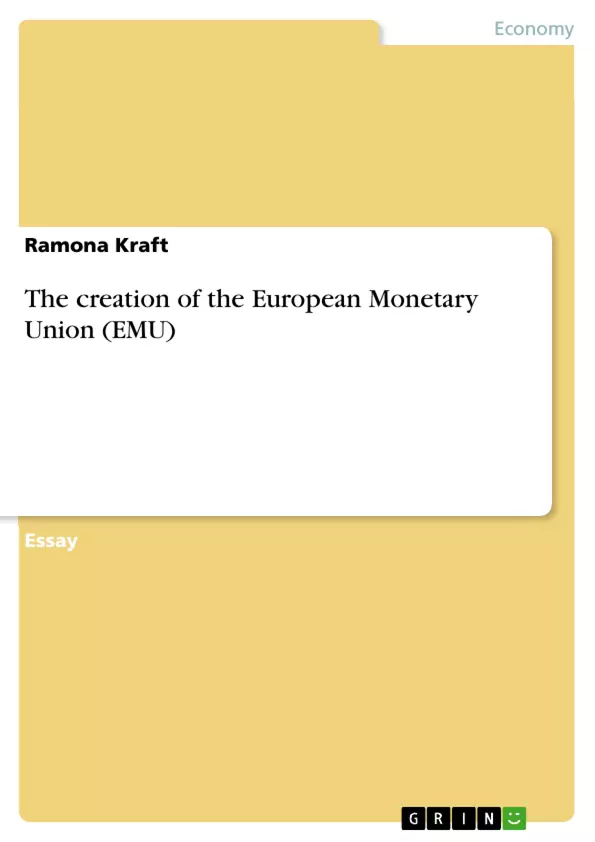The creation of the European and Monetary Union (EMU) has been one of the most determined and successful projects carried out by the European Union (EU) – and it is still in progress since eleven EU-countries are, following the Maastricht treaty, legally required to join the Eurozone as soon as they meet the convergence criteria. The reasons for the creation of EMU have been widely discussed among scholars; some focus on the request for political integration that would resulted from an EMU, some claim that the EMU was established to promote growth and investment. The assignment will hence “discuss how the creation of EMU was both an economic and politically driven process”. Chapter 1 outlines events and agreements which indirectly led to the EMU. Chapter 2 assesses the Delors Report and the Stability and Growth Pact (SGP) which affect EMU directly . Chapter 3 concludes by analysing the mentioned 30-year process leading to the EMU and gives a brief outlook. This approach has been chosen because it is essential to study the historical events leading to the Delors Report and finally the Treaty on European Union (TEU) in order to analyse the creation of EMU.
Inhaltsverzeichnis (Table of Contents)
- INTRODUCTION
- 1. PRECEDING EVENTS LEADING TO EMU
- 2. THE DELORS REPORT AND THE STABILITY AND GROWTH PACT
- 3. CONCLUSION
Zielsetzung und Themenschwerpunkte (Objectives and Key Themes)
This essay examines the creation of the European Monetary Union (EMU) as a complex process driven by both economic and political factors. It explores the historical events that led to the EMU, focusing on the Werner Report, the Stability and Growth Pact, and the Delors Report. The essay aims to analyze the motivations behind the creation of EMU, considering factors like trade stability, political integration, and economic growth.
- Economic motivations for EMU, including the desire for stable exchange rates and a stable monetary environment
- Political motives for EMU, such as fostering political integration and cooperation among European nations
- The influence of key actors and institutions, such as the Franco-German partnership and the role of the European Commission
- The impact of historical events, including the Bretton Woods system, the oil crisis, and the formation of the European Monetary System (EMS)
- The evolution of the EMU process, from initial proposals to the Maastricht Treaty and its subsequent development
Zusammenfassung der Kapitel (Chapter Summaries)
- Chapter 1: Preceding Events Leading to EMU: This chapter discusses the historical context leading to the creation of EMU, highlighting the concept of fixed exchange rates and the impact of the Bretton Woods system. It explores the Werner Report and the "snake in the tunnel" system, emphasizing the economic and political motives behind these early attempts at monetary integration.
- Chapter 2: The Delors Report and the Stability and Growth Pact: This chapter focuses on the Delors Report and its significance in shaping the trajectory of EMU. It examines the key recommendations of the report and the subsequent establishment of the Stability and Growth Pact, emphasizing the role of these documents in setting economic criteria for EMU membership.
Schlüsselwörter (Keywords)
The key terms and concepts explored in this essay include: European Monetary Union (EMU), European Union (EU), fixed exchange rates, Bretton Woods system, Werner Report, Delors Report, Stability and Growth Pact, political integration, economic stability, trade, monetary policy, European Currency Unit (ECU), Exchange-Rate Mechanism (ERM), Franco-German partnership, and the Maastricht Treaty.
- Quote paper
- Ramona Kraft (Author), 2006, The creation of the European Monetary Union (EMU), Munich, GRIN Verlag, https://www.grin.com/document/71937



